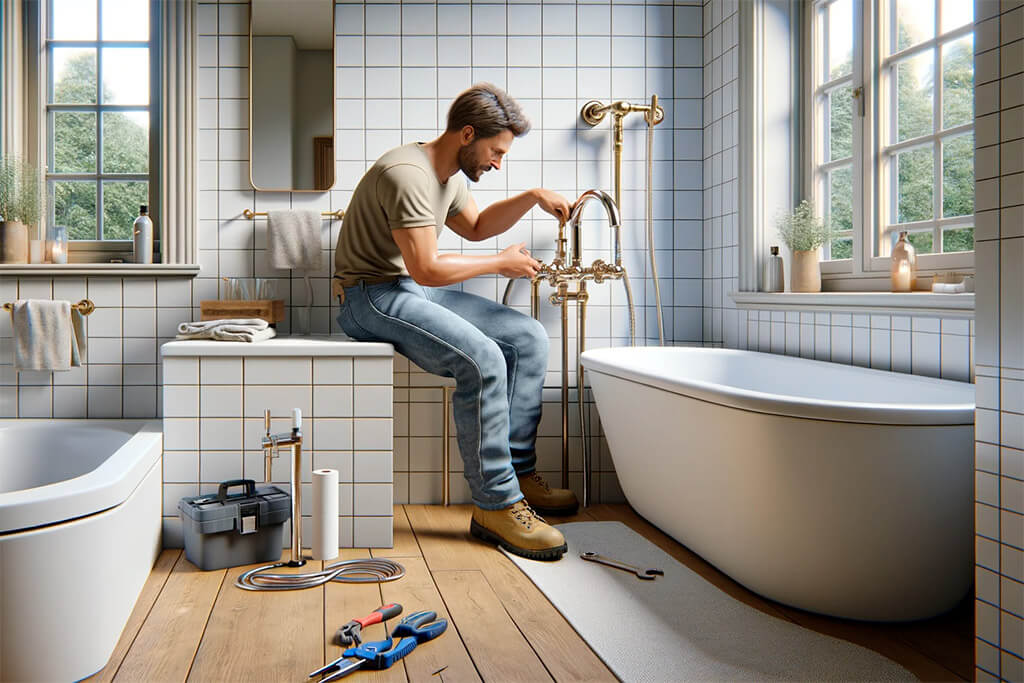In the world of home repairs, the ability to replace a bathtub faucet stands as a fundamental skill, akin to a rite of passage for both home handymen and self-employed construction professionals. This seemingly modest task can have a profound impact on the functionality and aesthetic of a bathroom. Embracing the spirit of DIY and professional craftsmanship alike, this guide aims to equip you with the knowledge and confidence to tackle this project head-on, regardless of your experience level.

Understanding Your Bathtub Faucet
When you look at your bathtub faucet, you’re seeing the tip of the iceberg. Beneath the surface, there’s a world of mechanics that dictate its function. Bathtub faucets generally fall into three categories:
- Single-handle Faucets: These are marvels of efficiency, controlling both flow and temperature with a single motion. Ideal for those seeking simplicity and minimalism.
- Double-handle Faucets: The traditional choice, offering separate controls for hot and cold water. They harken back to a classic era and demand a bit more finesse.
- Specialty Faucets: These can range from thermostatic valves, which maintain precise water temperature, to models with integrated diverters for shower use.
The call for replacement often comes from a few common symptoms: a persistent leak that defies basic repairs, visible wear like rust or limescale, or a handle that requires Herculean strength to operate. These are signs it’s time to upgrade or replace.
Tools and Materials Needed
In your tool belt, you’ll want:
- Wrenches: An adjustable wrench or a basin wrench, your choice for tackling nuts and bolts.
- Screwdrivers: Both Phillips and flat-head, catering to different screw types.
- Plumber’s Tape: This Teflon wonder helps secure a watertight seal.
- The New Faucet: It’s the star of the show, so choose wisely.
- Cleanup Gear: Towels and a bucket, because even the best of us can’t always control water.
Preparation Steps
Safety First
The cardinal rule before starting: turn off the water supply. This could be local valves near the tub or the main valve for your home. It’s a simple step that prevents an impromptu indoor flood.
Preparing the Workspace
Protect your bathroom’s surface with towels or a drop cloth. Arrange your tools where they’re easily reachable but not in the way. Good lighting is not just helpful, it’s essential. You don’t want to be guessing what you’re gripping.
Gathering Your Tools
Make a checklist. Include:
- Basic Tools: Wrenches and screwdrivers, the bread and butter of any plumbing job.
- Cleanup Supplies: Towels, buckets, and sponges to manage any water mess.
- The New Faucet: Ensure it’s the right fit and style for your bathroom.
Step-by-Step Guide to Replacing the Bathtub Faucet
1. Removing the Old Faucet
- Understanding the Setup: Start by getting familiar with the type of faucet you have. Each type, be it single, double, or something more complex, has its own unique removal process.
- Shutting Off Water: It’s essential to turn off the water supply before you begin. This step is non-negotiable to avoid an unexpected gush of water.
- Loosening Fixtures: Employ a wrench or a basin wrench for tight spots. For those pesky, corroded nuts, a dab of penetrating oil can work wonders.
- Handle Gently: If the handles are resistant, a gentle tap with a rubber mallet can help. Avoid forceful impacts that could damage your tub or the faucet.
- Removing the Faucet: Once loosened, the faucet should come off easily. If resistance is met, check for any concealed screws or corrosion.
2. Preparing for the New Faucet
- Clean the Area: A clean surface is critical for a proper installation. Remove any old plumber’s putty or debris.
- Measure for Accuracy: Ensure the new faucet aligns with the existing setup. Misalignment can lead to more work or an unsightly finish.
3. Installing the New Faucet
- Sealing Threads: Wrapping plumber’s tape around the new faucet’s threads ensures a leak-proof connection.
- Positioning the Faucet: Carefully place the faucet, making sure it’s aligned and level.
- Securely Fastening: Hand-tighten the connections before giving them a final snug with a wrench. Over-tightening can damage the fittings.
- Attaching Water Lines: Connect the water supply lines, being mindful of the proper threading direction.
4. Finishing Touches
- Testing for Leaks: Turn the water supply back on and observe. Leaks require immediate attention – better to catch them now than later.
- Operational Check: Test the faucet for both hot and cold water, checking for any issues in flow or temperature control.
- Tidy Up: Clear the area, put away your tools, and give the new faucet a final wipe-down.
In these steps, the focus is on precision and attention to detail. Remember, renovation is as much about the process as it is about the end result. Patience and careful planning will lead to a job well done, adding both function and value to your home.

Troubleshooting Common Problems
- Dealing with Leaks and Drips: Leaks can be persistent foes. If your newly installed faucet is dripping, it’s often a case of connections that need a bit more tightening, or perhaps the washer needs a second look. Be methodical, tighten connections bit by bit, and ensure washers are properly seated.
- Adjusting Water Pressure and Temperature Issues: Uneven water temperature or pressure issues post-installation can be a sign of crossed lines or a need for adjustments in the mixing valve. It’s a simple matter of checking the lines and making small adjustments until you achieve the desired balance.
- Solutions for Common Installation Mistakes: Even the most experienced hands can make a slip now and then. The key is not to rush and to double-check your work. If hot and cold are reversed, it’s a straightforward fix of switching the lines. If there’s a leak, reapply plumber’s tape and ensure a snug fit.

FAQ Section
Deciding between repair and replacement depends on a few factors. If the faucet is continually leaking, showing significant wear and tear, or not functioning properly despite repairs, it might be time to replace it. On the other hand, a minor issue like a worn washer or a loose part often just requires a simple repair.
This depends on your comfort level and experience with home projects. Replacing a bathtub faucet can be a manageable DIY project if you have basic plumbing knowledge and the right tools. However, if you’re unsure about any part of the process or if your plumbing system is particularly old or complex, it’s wise to call a professional.
The time it takes can vary based on the type of faucet and your experience level. Generally, you can expect to spend anywhere from one to three hours on the task. Remember, taking your time to ensure a job well done is more important than rushing through the process.
When selecting a faucet, look for models known for their durability and quality. Faucets with solid brass construction and ceramic disc valves are excellent choices for longevity and minimal maintenance.
Brands like Moen, Delta, and Kohler are known for their reliability and user-friendly design, making them good choices for DIY installations. They offer a variety of models to suit different styles and plumbing setups.
